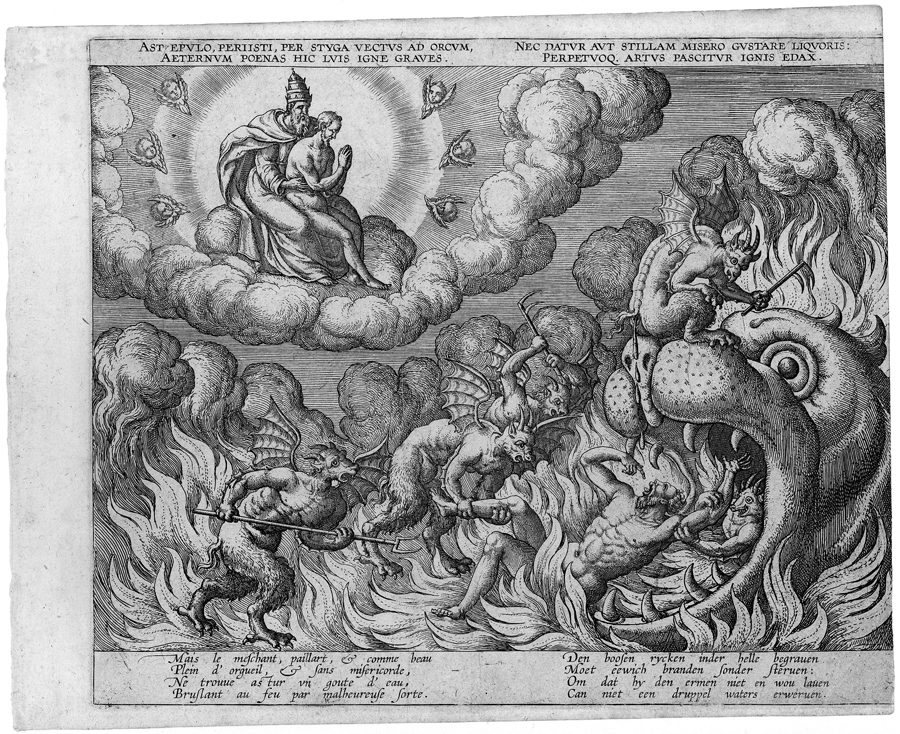Loading the page ...
Peeter van der Borcht
(ca. 1535 Malines or Brussels – 1608 Antwerp)
The Parable of the Rich Man and Poor Lazarus. Set of 4 etchings. 24.2 x 29.6 cm. The New Hollstein 84–87. Watermark: Shield of arms (similar to Briquet 9819, after 1588).
These four illustrations to the Parable of Lazarus are an important new discovery, as up to now only two prints of the series were known to be collocated in museum collections. As Ger Luijten observes in the preface to the New Hollstein volume on this artist (The New Hollstein, Peeter Van der Borcht, Rotterdam 2004, p. VII), Van der Borcht has been somewhat unjustly treated by art history. Despite being an influential and productive artist in his lifetime, Van der Borcht’s etchings are rare, a fact that is rather surprising, since many of his inventions were copied by other artists and his prints re-issued until well into the 17th century. Given their popularity at the time, Van der Borcht’s didactic suites of etchings on moral and religious themes must have gone through very large editions, especially as the artist worked for such leading Antwerp publishers as Christoph Plantin, Adriaen Huybrechts, Johannes Baptista Vrients and Philips Galle.
The unforgotten Hans Mielke (d. 1994) and Ursula Mielke deserve no little credit for having furnished more precise information about Van der Borcht’s activity as a printmaker and for having added several hitherto unknown prints to the œuvre.
Details of the artist’s life are few and far between. It is known that Van der Borcht was a member of the painters’ guild in Malines from 1559 on. In 1572 he fled for unknown reasons to Antwerp, where he became a master in 1580. Van der Borcht must have gained a measure of esteem in Antwerp, for he was dean of the Guild of Saint Luke from 1589 to 1592 and was made a citizen in 1597.
For the present series on The Parable of the Rich Man and Poor Lazarus Van der Borcht evidently provided the drawings, which served as models and then probably were etched by another artist working under his supervision. The individual scenes, however, clearly bear Van der Borcht’s artistic signature and are executed in a very detailed and refined style. Their elaborately theatrical nature is striking. The four episodes have a complex compositional and spatial structure. Each scene presents an abundance of anecdotal and still-life-like detail. The lively movements of the protagonists – observe the antics of the carousers at their feasting and the waiter tripping along with a dancing gait! – lend the story dash and colour. The antithesis between the leprous Lazarus and the grossly obese rich man is shown in such a convincing way that one could almost wish the punishment of hellfire on the heartless sinner!
The complete set is extremely rare. Ursula Mielke only knew the first and second plates of the set, which are in Brussels (Prentenkabinet. Koninklijke Bibliotheek Albert I); The New Hollstein merely reproduces copies of the two other prints. Good (Hollstein 87) to very fine, harmonious and even impressions with wide margins around the platemark, printed on the full album sheet. The sheet size of Hollstein 87 is identical with the other etchings of the set, but the image is minimally trimmed into the subject on the right, due to the contemporary cutting of the paper sheet. Minimal aging and minor defects, otherwise in perfect condition.
